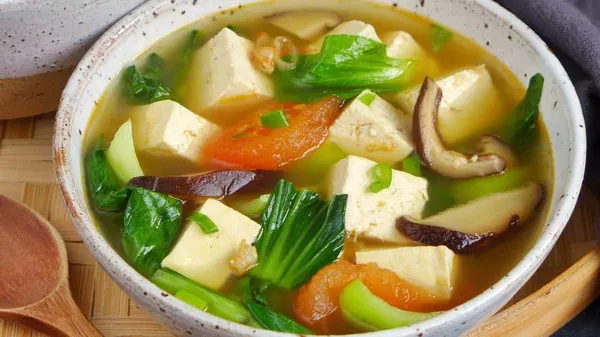In the realm of Chinese cuisine, tofu soup stands out as a beloved dish celebrated for its delicate flavors and nourishing qualities. This classic dish, often prepared with a harmonious blend of ingredients, showcases the artistry and subtlety of Chinese cooking. Whether you’re a seasoned chef or an adventurous home cook, mastering the art of Chinese tofu soup promises to elevate your culinary repertoire. Let’s embark on a journey to explore the essence of this beloved dish and learn how to create it authentically in your own kitchen.
Understanding the Foundation: Tofu as the Heart of the Soup
At the core of any good tofu soup lies, of course, the tofu itself. Tofu, also known as bean curd, is a protein-rich, versatile ingredient made from coagulated soy milk. Its mild flavor and sponge-like texture make it an ideal canvas for absorbing the flavors of the broth and other ingredients.
For an authentic Chinese tofu soup, opt for silken or soft tofu varieties. These types of tofu are delicate and silky, providing a luxurious mouthfeel to the soup. When choosing tofu, look for fresh, high-quality options from Asian markets or well-stocked grocery stores.
Selecting the Right Broth: A Balance of Flavors
The broth is the backbone of any soup, and in Chinese cuisine, it’s no different. To create an authentic Chinese tofu soup, you’ll want a broth that is savory, aromatic, and well-balanced. Traditional choices include chicken broth, pork bone broth, or vegetable broth.
For a homemade broth, start by simmering bones (chicken or pork) or a combination of vegetables like onions, garlic, and ginger in water for several hours. This slow-cooking process extracts flavors and creates a rich, flavorful base. Season the broth with soy sauce, a touch of rice wine, and a hint of sweetness from rock sugar to achieve that distinct umami taste characteristic of Chinese soups.
Enhancing Flavor with Aromatics and Vegetables
To elevate your tofu soup, incorporate a variety of aromatics and vegetables. Common additions include sliced shiitake mushrooms, bamboo shoots, water chestnuts, and leafy greens like bok choy or napa cabbage. These ingredients not only contribute flavor but also add texture and visual appeal to the soup.
Infuse the broth with aromatics such as garlic, ginger, and scallions. These aromatic elements provide depth and complexity to the soup’s flavor profile. For a spicy kick, consider adding a dash of white pepper or a few drops of sesame oil.
Adding Protein: The Art of Balance
While tofu serves as the primary protein source in tofu soup, additional proteins can be included to make the dish more substantial. Slices of cooked chicken, pork, or seafood like shrimp or fish balls are popular choices. These proteins should be added towards the end of cooking to prevent them from becoming tough or overcooked.
To maintain the delicate texture of tofu, handle it gently when adding it to the simmering broth. Use a spoon or spatula to carefully slide the tofu into the soup, ensuring it remains intact.
Seasoning and Adjustments: The Final Touches
The key to a stellar tofu soup lies in the art of seasoning. Taste the soup as it simmers and adjust the seasoning accordingly. Add more soy sauce for saltiness, a touch of sugar to balance the flavors, or a splash of rice vinegar for a hint of tanginess.
For those who prefer a heartier soup, consider thickening the broth slightly with a cornstarch slurry. Mix equal parts cornstarch and water, then slowly stir this mixture into the simmering soup until it reaches your desired consistency.
Presentation and Serving Suggestions
In Chinese culinary tradition, presentation is just as important as taste. Serve your tofu soup hot in individual bowls, garnished with freshly chopped cilantro or scallions for a burst of freshness. Accompany the soup with steamed rice or a side of crispy fried wontons for a complete meal experience.
For an added touch of authenticity, consider serving the tofu soup alongside other classic Chinese dishes like stir-fried vegetables or dumplings. The combination of flavors and textures will delight your taste buds and transport you to the heart of Chinese dining.
Experimentation and Creativity: Making the Recipe Your Own
While tradition forms the foundation of Chinese cooking, there’s ample room for creativity and personalization. Feel free to experiment with different ingredients and flavor profiles to suit your palate. For a vegetarian twist, swap out the meat-based broth for a robust vegetable broth and load up on seasonal vegetables.
Additionally, explore regional variations of tofu soup across China. Each province boasts its own unique interpretation, influenced by local ingredients and culinary traditions. Whether it’s Sichuan’s fiery mapo tofu soup or the delicate tofu flower soup from Jiangsu, let your culinary curiosity guide you.
Conclusion
In conclusion, mastering the art of Chinese tofu soup opens a world of culinary possibilities. With attention to detail and a respect for tradition, you can recreate this beloved dish in your own kitchen. Remember, the key lies in sourcing quality ingredients, balancing flavors harmoniously, and infusing each spoonful with a touch of passion.
So, roll up your sleeves, gather your ingredients, and embark on a culinary journey through the flavors of China. Whether you’re seeking comfort on a chilly evening or aiming to impress dinner guests, Chinese tofu soup is sure to leave a lasting impression. Cheers to good food and culinary adventures!
Related Topics:
What Is the Best Chinese Food for Diabetics


























